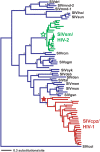Dating the age of the SIV lineages that gave rise to HIV-1 and HIV-2
- PMID: 19412344
- PMCID: PMC2669881
- DOI: 10.1371/journal.pcbi.1000377
Dating the age of the SIV lineages that gave rise to HIV-1 and HIV-2
Abstract
Great strides have been made in understanding the evolutionary history of simian immunodeficiency virus (SIV) and the zoonoses that gave rise to HIV-1 and HIV-2. What remains unknown is how long these SIVs had been circulating in non-human primates before the transmissions to humans. Here, we use relaxed molecular clock dating techniques to estimate the time of most recent common ancestor for the SIVs infecting chimpanzees and sooty mangabeys, the reservoirs of HIV-1 and HIV-2, respectively. The date of the most recent common ancestor of SIV in chimpanzees is estimated to be 1492 (1266-1685), and the date in sooty mangabeys is estimated to be 1809 (1729-1875). Notably, we demonstrate that SIV sequences sampled from sooty mangabeys possess sufficient clock-like signal to calibrate a molecular clock; despite the differences in host biology and viral dynamics, the rate of evolution of SIV in sooty mangabeys is indistinguishable from that of its human counterpart, HIV-2. We also estimate the ages of the HIV-2 human-to-human transmissible lineages and provide the first age estimate for HIV-1 group N at 1963 (1948-1977). Comparisons between the SIV most recent common ancestor dates and those of the HIV lineages suggest a difference on the order of only hundreds of years. Our results suggest either that SIV is a surprisingly young lentiviral lineage or that SIV and, perhaps, HIV dating estimates are seriously compromised by unaccounted-for biases.
Conflict of interest statement
The authors have declared that no competing interests exist.
Figures


References
-
- Gao F, Bailes E, Robertson DL, Chen Y, Rodenburg CM, et al. Origin of HIV-1 in the chimpanzee Pan troglodytes troglodytes. Nature. 1999;397:436–441. - PubMed
-
- Damond F, Worobey M, Campa P, Farfara I, Colin G, et al. Identification of a highly divergent HIV type 2 and proposal for a change in HIV type 2 classification. AIDS Res Hum Retroviruses. 2004;20:666–672. - PubMed
-
- Hirsch VM, Olmsted RA, Murphey-Corb M, Purcell RH, Johnson PR. An African primate lentivirus (SIVsm) closely related to HIV-2. Nature. 1989;339:389–392. - PubMed
-
- Korber B, Muldoon M, Theiler J, Gao F, Gupta R, et al. Timing the ancestor of the HIV-1 pandemic strains. Science. 2000;288:1789–1796. - PubMed
Publication types
MeSH terms
LinkOut - more resources
Full Text Sources

